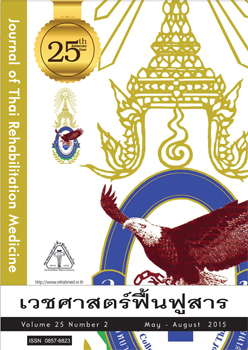การศึกษานำร่องเพื่อเปรียบเทียบรูปแบบการเดินเมื่อใส่และ ไม่ใส่เครื่องกระตุ้นเส้นประสาทด้วยไฟฟ้าขณะเดิน “เครื่อง เดินดีTM” ในผู้ป่วยโรคหลอดเลือดสมองที่มีปลายเท้าตก
Keywords:
“เครื่องเดินดีTM”, เครื่องกระตุ้นเส้นประสาทด้วยไฟฟ้าขณะเดิน, ปลายเท้าตก, รูปแบบการเดิน, โรคหลอดเลือดสมอง, DearndeeTM, functional electrical stimulation (FES), foot drop, gait pattern, strokeAbstract
Comparison of Gait Pattern during Walking with and without Functional Electrical Stimulation “DearndeeTM” in Stroke Patients with Foot Drop: a Pilot Study
Chayaratanasin P, Vongpipatana S and Chira-Adisai W
Rehabilitation Medicine Department, Faculty of Medicine Ramathibodi Hospital, Mahidol University
Objective: To compare gait pattern during walking with and without functional electrical stimulation “DearndeeTM” for foot drop in terms of gait velocity, time in each phases of gait cycle and angle of hip and knee motion in foot- drop patients.
Study design: Experimental study
Setting: Rehabilitation Medicine Department, Faculty of Medicine, Ramathibodi Hospital
Subjects: Patients with foot drop from upper motor neuron lesion
Methods: Gait velocity was measured while subjects randomly walked either with or without “DearndeeTM”. Time during each phases of gait cycle was assessed by using computer dynography. Video recording was used for assessing the angle of hip and knee motion during walking.
Results: Subject group was thirteen stroke patients. Eight patients were right and five patients were left hemiparesis with mean age (range) of 43.69 (22-65) years. For the affected leg during walking with and without “DearndeeTM”, median (range) of swing and stance time were 0.70 (0.45-1.21), 0.97 (0.52-3.07) and 1.16 (0.89-2.83), 1.02 (0.70-1.47) seconds, respectively. Mean (standard deviation; S.D.) of angle of hip abduction, flexion and knee flexion were 6.63 (6.53), 6.97 (4.56) and 16.45 (13.72), 16.00 (12.43) and 25.17 (16.67), 30.63 (14.20) degrees, respectively. Mean gait velocities (S.D.) were 0.51 (0.28) and 0.52 (0.30) meter per second, respectively. Only swing and stance time of the affected leg were significantly changed at p<0.05.
Conclusion: Functional electrical stimulation “DearndeeTM” could make the foot-drop leg swing faster and stance longer but no significant change in angle of hip and knee motion. The device does not change the stroke patient’s gait velocity.
บทคัดย่อ
วัตถุประสงค์: เพื่อเปรียบเทียบรูปแบบการเดินเมื่อใส่และไม่ใส่เครื่องกระตุ้นเส้นประสาทด้วยไฟฟ้า “เครื่องเดินดีTM” ในแง่ความเร็วในการเดิน ระยะเวลาในแต่ละช่วงเวลาการเดิน และมุมการเคลื่อนไหวข้อสะโพกและข้อเข่าในผู้ป่วยโรคหลอดเลือดสมองที่มีปลายเท้าตก
รูปแบบการวิจัย: การวิจัยเชิงทดลอง
สถานที่ทำการวิจัย: ภาควิชาเวชศาสตร์ฟื้นฟู คณะแพทยศาสตร์โรงพยาบาลรามาธิบดี
กลุ่มประชากร: ผู้ป่วยโรคหลอดเลือดสมองที่มีปลายเท้าตก
วิธีการศึกษา: ทดสอบหาค่าความเร็วในการเดิน ใช้เครื่องวัดแรงกระทำในแนวดิ่ง (computer dynography) เพื่อวัดระยะเวลาในแต่ละช่วงเวลาของการเดิน และบันทึกภาพเพื่อวัดมุมการเคลื่อนไหวของสะโพกและเข่า เมื่อผู้ร่วมวิจัยใส่และไม่ใส่“เครื่องเดินดีTM” โดยสุ่มลำดับในการทดสอบ
ผลการศึกษา: ผู้ป่วย 13 คน อ่อนแรงซีกขวา 8 คน ซีกซ้าย 5 คน อายุเฉลี่ย (ช่วงอายุ) 43.69 (22-65) ปี สำหรับขาข้างที่มีปลายเท้าตกเมื่อใส่และไม่ใส่ “เครื่องเดินดีTM” พบว่า ค่ามัธยฐาน (ช่วง) ของระยะเวลาในการเหวี่ยงเท้า (swing time) และระยะเวลาที่เหยียบพื้น (stance time) คือ 0.70 (0.45-1.21), 0.97 (0.52-3.07) และ 1.16 (0.89-2.83), 1.02 (0.70-1.47) วินาที ตามลำดับ ค่าเฉลี่ย (ค่าเบี่ยงเบนมาตรฐาน) ของมุมกางสะโพก งอสะโพก และงอเข่า คือ 6.63 (6.53), 6.97 (4.56) และ 16.45 (13.72), 16.00 (12.43) และ 25.17 (16.67), 30.63 (14.20) องศา ตามลำดับ ค่าเฉลี่ย (ค่าเบี่ยงเบนมาตรฐาน) ของความเร็วในการเดิน คือ 0.51 (0.28) และ 0.52 (0.30) เมตรต่อวินาที ซึ่งพบว่ามีเพียง swing และ stance time ของขาข้างที่มีปลายเท้าตกเปลี่ยนแปลงอย่างมีนัยสำคัญทางสถิติ (p<0.05)
ผลสรุป: “เครื่องเดินดีTM” ทำให้ขาข้างที่มีปลายเท้าตกเหวี่ยงได้เร็วขึ้น และเหยียบพื้นได้นานขึ้น แต่ไม่มีผลต่อมุมการเคลื่อนไหวของสะโพกและเข่า รวมทั้งความเร็วในการเดินของผู้ป่วยโรคหลอดเลือดสมอง






